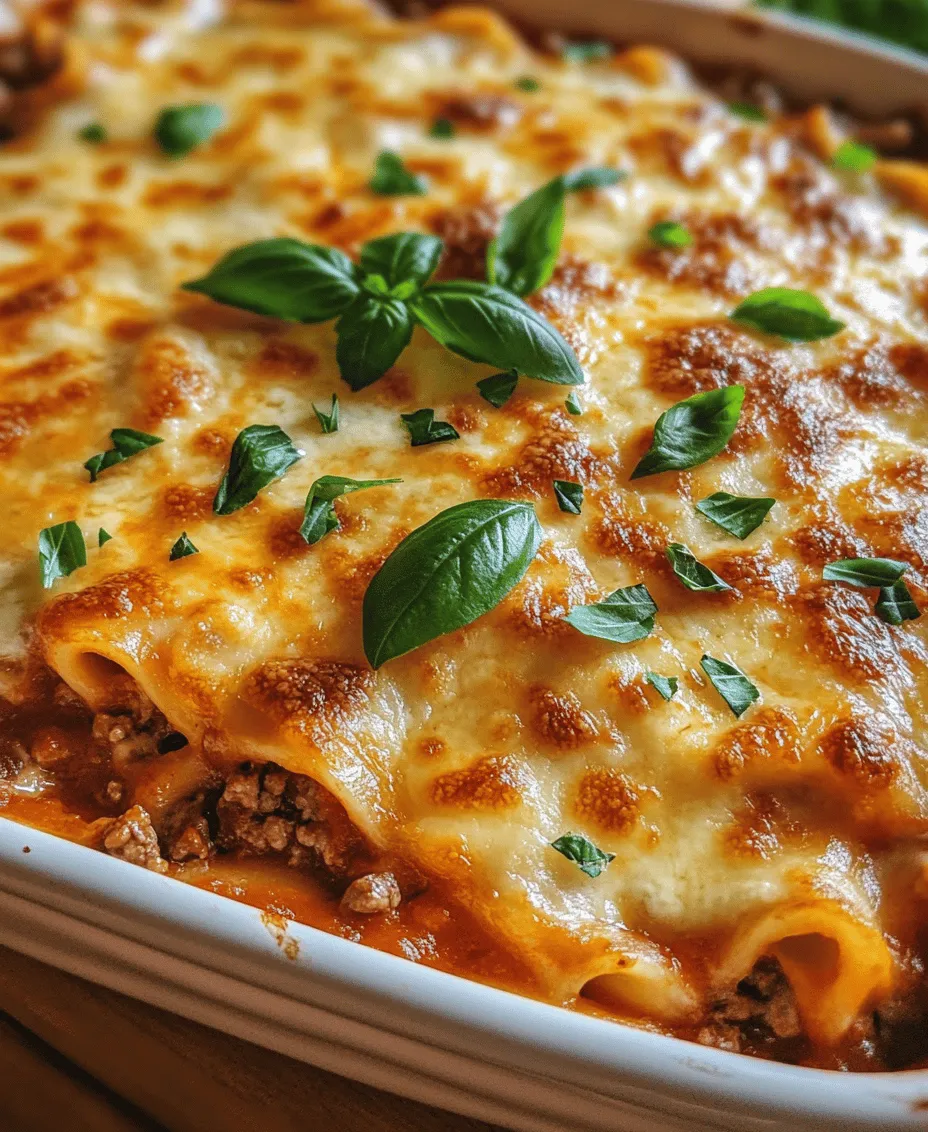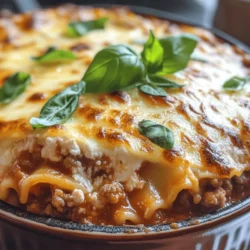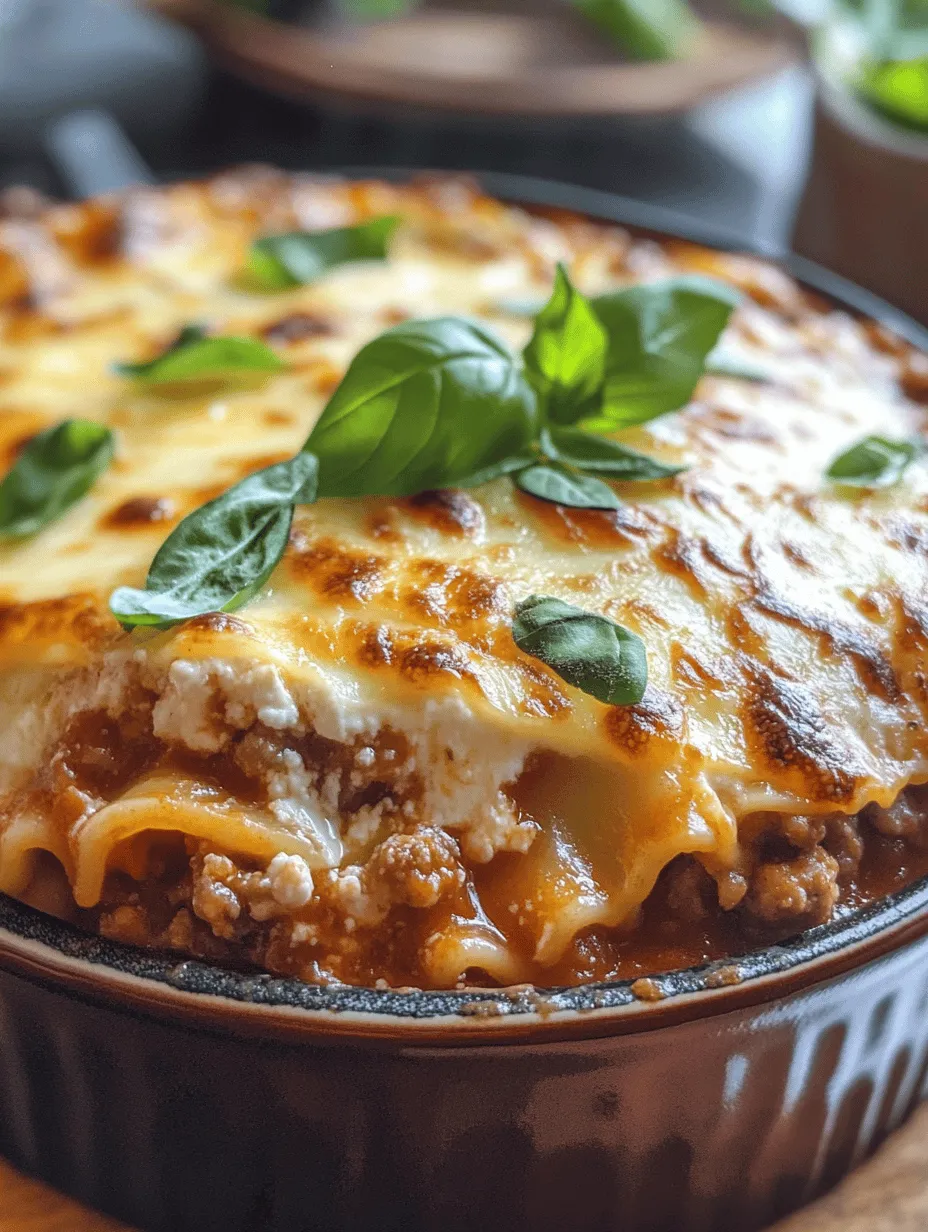Introduction
Lasagna is a culinary classic that has been cherished across generations and cultures. This layered pasta dish, rich with flavor and comfort, combines the satisfying textures of tender noodles, savory meat sauce, and creamy cheese into a hearty meal that warms the soul. Whether enjoyed at family gatherings, holiday celebrations, or intimate dinners, lasagna holds a special place in the hearts (and stomachs) of many food lovers.
In an age where convenience often trumps tradition, the importance of homemade meals cannot be overstated. Cooking from scratch not only allows you to control the quality of ingredients but also creates an opportunity to bond with loved ones over shared culinary experiences. The act of preparing a meal together fosters connection and creates lasting memories. This easy homemade lasagna recipe is the perfect solution for family dinners, allowing you to create a delicious dish that everyone will enjoy, while also making the process simple and accessible.
Understanding Lasagna
Lasagna’s roots can be traced back to ancient Greece, where a dish called Laganon, made of layers of pasta and sauce, was served. However, it was in Italy where lasagna evolved into the beloved dish we know today. The traditional Italian version, particularly from the regions of Emilia-Romagna, features layers of pasta, a rich meat sauce, béchamel sauce, and a generous sprinkle of cheese. Over the years, lasagna has adapted to various cultures, resulting in a plethora of regional variations. From the classic meat lasagna to vegetarian versions packed with seasonal vegetables, there is a lasagna recipe for every palate.
Aside from being a delicious meal, homemade lasagna offers numerous nutritional benefits compared to its store-bought counterparts. When you prepare lasagna at home, you have the opportunity to select high-quality ingredients, adjust flavors, and control portion sizes. For instance, using fresh vegetables instead of canned can boost the dish’s nutritional profile while enhancing its flavor. Moreover, homemade lasagna allows you to tailor the recipe to accommodate dietary preferences, such as gluten-free or vegetarian options, ensuring everyone at the table can indulge.
Ingredients Breakdown
Before diving into the preparation of your easy homemade lasagna, it’s essential to understand the key ingredients that will bring this dish to life. The foundational elements of a classic lasagna include lasagna noodles, a rich meat sauce, ricotta cheese, mozzarella cheese, and Parmesan cheese.
– Lasagna Noodles: Traditional lasagna noodles are flat sheets of pasta that create the layers of the dish. Opt for no-boil noodles for convenience, or regular noodles if you prefer a more authentic texture.
– Meat Sauce: A combination of ground beef or Italian sausage, onions, garlic, and marinara sauce forms the heart of the lasagna. The meat sauce adds depth and richness, making each bite a delight.
– Cheese: Ricotta cheese contributes creaminess, while mozzarella provides that gooey, melty texture. Parmesan cheese adds a nutty flavor that elevates the dish.
– Herbs and Spices: Fresh herbs like basil and oregano enhance the overall flavor profile, while salt and pepper balance the dish.
When preparing your lasagna, the quality of ingredients plays a pivotal role in the final outcome. Fresh herbs, high-quality cheese, and homemade marinara sauce can significantly elevate the dish’s taste and texture. In addition, for those with dietary restrictions, there are numerous ingredient substitutions available. For a vegetarian version, simply replace the meat sauce with a mix of sautéed vegetables, such as spinach, mushrooms, and zucchini. For gluten-free options, consider using gluten-free lasagna noodles or thinly sliced zucchini or eggplant in lieu of traditional pasta layers.
Preparation Steps
Preheating the Oven
Before you start assembling your lasagna, it’s crucial to preheat your oven to the appropriate temperature. A typical lasagna is baked at 375°F (190°C). Preheating ensures that the lasagna cooks evenly, allowing the flavors to meld beautifully while achieving that perfect golden-brown top.
Cooking the Lasagna Noodles
Next, you’ll need to prepare the lasagna noodles. If you’re using traditional noodles, bring a large pot of salted water to a boil. Cook the noodles according to the package instructions until they are al dente, usually around 8-10 minutes. Be careful not to overcook them, as they will continue to cook in the oven. After boiling, drain the noodles and rinse them under cold water to stop the cooking process and prevent them from sticking together.
If you prefer a lighter option, consider using zucchini slices as a substitute for noodles. This gluten-free alternative adds flavor and nutrients while reducing carbohydrates. Simply slice the zucchini thinly lengthwise and pat dry to remove excess moisture before layering.
Creating the Meat Sauce
The meat sauce is the heart of any lasagna. To start, heat a large skillet over medium heat and add a drizzle of olive oil. Once hot, add finely chopped onions and sauté until they become translucent, about 5 minutes. Then, add minced garlic and cook for an additional minute, until fragrant.
Next, incorporate your choice of ground beef or Italian sausage into the skillet. Use a wooden spoon to break the meat apart as it browns, which usually takes about 7-10 minutes. Once the meat is fully cooked, drain any excess fat to keep the sauce from becoming greasy.
After the meat is browned, it’s time to introduce the marinara sauce. For the best flavor, opt for a high-quality store-bought marinara or, even better, make your own from scratch. Combine the meat with the marinara sauce and let it simmer for about 15-20 minutes, allowing the flavors to meld. Season with salt, pepper, and fresh herbs like basil and oregano to enhance the sauce’s depth.
Preparing your homemade lasagna with these steps not only ensures a delicious outcome but also allows you to take pride in the cooking process. The following sections will guide you through assembling the lasagna and baking it to perfection, leading to a dish that is sure to impress your family and friends.

Suggestions for Homemade vs. Store-Bought Sauce
When it comes to lasagna, the sauce you choose can significantly impact the overall flavor of the dish. While store-bought sauces can save time, making homemade sauce allows you to customize flavors to your liking and control the quality of ingredients. If you’re short on time or simply looking for convenience, opt for a high-quality jarred marinara or pasta sauce. Look for options labeled as “organic” or “no added sugars” to ensure you’re getting a product with fewer preservatives.
However, if you have the time and inclination, preparing homemade marinara sauce is a worthwhile endeavor. A basic recipe typically includes sautéing onions and garlic in olive oil, then adding crushed tomatoes, herbs like basil and oregano, and a dash of salt and pepper. Simmering the sauce for at least 30 minutes allows the flavors to meld beautifully, resulting in a richer taste that elevates your lasagna. Whether you choose homemade or store-bought, ensure that the sauce is flavorful and well-seasoned to create a delicious lasagna.
Making the Cheese Filling
Step-by-Step Guide to Preparing the Ricotta Cheese Mixture
The cheese filling is a critical component of a delicious lasagna. To create a creamy and flavorful filling, you will need ricotta cheese as your base. Here’s how to prepare the cheese mixture:
1. Gather Ingredients: You will need 15 ounces of ricotta cheese, 1 large egg, 1 cup of grated Parmesan cheese, 2 cups of shredded mozzarella cheese, and a handful of fresh herbs like parsley or basil (optional).
2. Combine the Ingredients: In a large mixing bowl, add the ricotta cheese, egg, grated Parmesan, and a pinch of salt and pepper. Using a fork or a whisk, mix everything together until fully combined. If desired, chop and fold in fresh herbs for added flavor.
3. Adjust Consistency: If the mixture seems too thick, you can add a splash of milk to achieve a creamier texture. Be careful not to make it too runny, as it should hold its shape when layered in the lasagna.
Explanation of the Role of Egg in the Filling
The addition of an egg in the ricotta cheese mixture serves a crucial function. It acts as a binder, helping to hold the cheese filling together and providing structure to the lasagna. This not only prevents the filling from becoming watery during baking but also contributes to the overall creaminess of each bite. The egg also enriches the flavor, making the filling more decadent.
Tips for Enhancing the Cheese Mixture with Additional Herbs or Spices
To elevate your cheese filling, consider adding various herbs and spices to suit your taste. Fresh basil, oregano, or thyme can complement the flavors of the sauce and noodles beautifully. For a bit of kick, a pinch of crushed red pepper flakes can be incorporated. If you prefer a more savory note, consider adding garlic powder or onion powder. Remember to taste the filling as you go, making adjustments to ensure it aligns with your flavor preferences.
Layering the Lasagna
The art of layering lasagna is essential to achieving the perfect balance of flavors and textures. A well-layered lasagna not only looks appealing but also ensures that each bite delivers a harmonious blend of noodles, cheese, and sauce.
Importance of Proper Layering for Texture and Flavor
Proper layering helps distribute flavors evenly throughout the dish. Each component contributes to the overall experience, so it’s important to layer thoughtfully. Starting with a layer of sauce at the bottom prevents the noodles from sticking and adds moisture, followed by the noodles, cheese mixture, and more sauce. This process is repeated, creating a multi-layered masterpiece.
Visual Description of Each Layer
1. First Layer: Begin with a thin layer of marinara sauce spread evenly on the bottom of your baking dish. This creates a non-stick base for the noodles.
2. Noodles: Place the first layer of lasagna noodles over the sauce, ensuring they do not overlap. You can use traditional or no-boil noodles, depending on your preference.
3. Cheese Mixture: Spread a generous layer of the ricotta cheese mixture over the noodles, smoothing it out for an even distribution.
4. More Sauce: Spoon marinara sauce over the cheese layer, ensuring it covers the cheese evenly.
5. Mozzarella: Sprinkle shredded mozzarella cheese over the sauce, providing a gooey, cheesy layer.
Repeat these layers until you run out of ingredients, finishing with a layer of sauce topped with mozzarella cheese for a beautifully melty cap.
Common Layering Mistakes to Avoid
To achieve the best results, avoid these common layering mistakes:
– Overlapping Noodles: Ensure that noodles do not overlap, as this can lead to uneven cooking and texture.
– Skipping the Sauce: Never skip the sauce between layers. This keeps the noodles moist and prevents the lasagna from drying out.
– Too Much Filling: Use a moderate amount of filling. Overloading can cause the lasagna to overflow and become difficult to serve.
Baking the Lasagna
Baking your lasagna correctly is crucial to achieving that perfect, bubbling dish.
Explanation of Baking Times and Techniques
Preheat your oven to 375°F (190°C). Once your lasagna is assembled, cover it with aluminum foil to trap moisture and prevent the cheese from burning. Bake for about 25 minutes covered, then remove the foil and continue baking for an additional 15 to 20 minutes. This final uncovered baking stage allows the cheese to melt and turn golden brown.
Importance of Foil Coverage During Baking
Covering the lasagna with foil during the initial baking period is essential. It helps to steam the lasagna and ensures that the noodles cook thoroughly without drying out. Removing the foil for the last part of the baking process allows for that desired bubbly, golden crust on top.
Signs That Your Lasagna is Perfectly Cooked
You’ll know your lasagna is cooked perfectly when the cheese is bubbling and has a golden brown color. A knife inserted into the center should come out hot and clean, indicating that the layers are heated throughout. If you see bubbling sauce around the edges, you’re in for a delicious treat.
Allowing the Lasagna to Rest
Once your lasagna is out of the oven, patience is key. Allow it to rest for at least 15 to 20 minutes before slicing.
Importance of Letting the Dish Rest Before Serving
Resting the lasagna is crucial for two primary reasons. First, it allows the layers to set, making it easier to slice and serve neatly. Second, resting enhances the flavor as the ingredients meld together during this time, resulting in a more satisfying taste.
Serving Suggestions
When it comes to serving your homemade lasagna, presentation and pairings can elevate the entire meal.
Ideas for Garnishing Lasagna
Garnishing your lasagna can add a fresh touch. A sprinkle of chopped fresh basil or parsley adds color and a burst of flavor. For an extra indulgent touch, consider adding grated Parmesan cheese on top just before serving.
Recommended Side Dishes That Pair Well with Lasagna
Pair your lasagna with a crisp side salad dressed in a light vinaigrette to balance the richness of the dish. Garlic bread is another classic pairing, perfect for soaking up any leftover sauce. A side of roasted vegetables can also complement the meal nicely, adding a healthy element.
Tips for Storing Leftovers and Reheating
Leftover lasagna can be stored in an airtight container in the refrigerator for up to four days. To reheat, place slices in a baking dish, cover with foil, and warm in a preheated oven at 350°F (175°C) until heated throughout. You can also reheat individual portions in the microwave, though the oven will help maintain the texture of the cheese.
Conclusion
Homemade lasagna is a heartwarming dish that brings families and friends together, making it a cherished recipe in any home. The process of creating this layered wonder—from the rich sauce to the creamy cheese filling and perfectly baked layers—offers an opportunity to express your culinary creativity while providing comfort to those you love.
As you embark on this culinary adventure, don’t hesitate to make the recipe your own by experimenting with different ingredients and flavors. Share your lasagna with family and friends, and create lasting memories around the dinner table. The beauty of lasagna lies in its versatility, allowing you to adapt it to suit any occasion. So roll up your sleeves, gather your ingredients, and enjoy the delightful experience of making and sharing this classic Italian dish.


